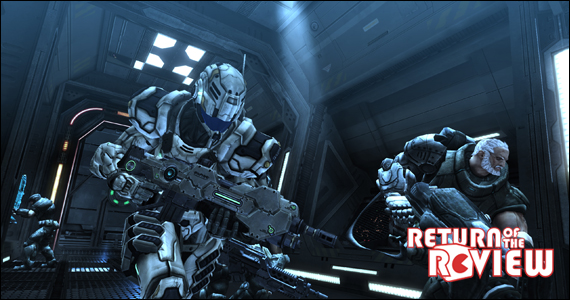
In my capacity as a Sugarperson, I really only serve two functions: sometimes I manufacture prettiness in an effort to make it appear that the site was not, in fact, designed in my basement, and other times I play games, and then I tell you about them. This is one of those times. As tasks go, it is not the worst one could hope for. In fact, the only way it could be better is if it caused the numbers on my bank account to increase, or perhaps if writing overly long sentences made me irresistible to nerd girls.
Vanquish is a game that, upon playing, I was compelled to fulfill this second duty; to write words and deliver them to you, so that you might understand their meaning. Accordingly, in addition to our regular review of Vanquish, I am here to provide a rare second opinion. Let’s begin: if anyone tells you that Vanquish is not worth playing, your duty is clear. Cut this person out of your life forever, as this person is a liar who wishes only misfortune upon you. If, after taking this action, you still doubt the value of Vanquish, I suggest the following: visit youtube, and search for “Casshern.” When you come to the inevitable realization that “There should be a videogame of this,” return here, and I will present to you, Vanquish.
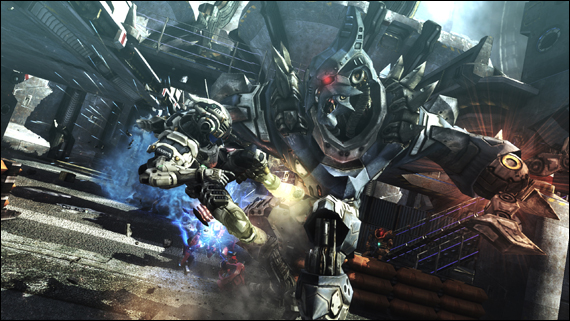
Vanquish is a game that brings cutscene fantasies into sharp physical dimension, which is to say Vanquish is a game where you play in ways most other games only look like in cutscenes. In some other title, a character moving the way the player does in Vanquish could only be a boss, destroying you endlessly with his superior speed and maneuverability, with his unstoppable attacks. Perhaps you understand the implications of such a claim: in Vanquish, you are the boss. The thrill of firing your weapon as you blast across the terrain on your rocket-knees, shotgun enemies while falling through the air, or dispatch three robots at once while vaulting over cover is an almost physical sensation; the developers have distilled the science fiction action fantasies of nerds everywhere into a delivery of pure and unadulterated videogame joy.
The core of Vanquish is the ARS suit, which allows players enhanced mobility and the option to engage an augmented reaction mode, which slows down time. This feature can be activated at a number of times, be it while vaulting over cover or falling through the air after delivering a devastating backflip kick, and much of the learning curve in Vanquish revolves around discovering new methods and new attack patterns utilizing this ability.
I eventually realized that my ARS gauge would never increase or be upgraded, and this was a moment of mild disappointment—but it passed as I began to understand that the skill in Vanquish is in maximizing your use of the system. In that respect, knowing, instinctually, how long you have until your suit burns out (because it never changes) is incredibly valuable—you’ll always be shooting to hang on to that last sliver. By the time the final act rolls around, players will find themselves well oiled machines, always dodging, always firing, always bounding across the map and tearing into enemies.
This would all be in vain if not for the mathematically precise controls. It’s fair to say this is an area where the Japanese excel; your character will do exactly the things you tell him to do, and this is critical to the ludicrously fast-paced Vanquish and its waves of unrelenting enemies. Weapon design is equally deliberate with a selection of niche-weapons in addition to the all-purpose assault rifle and heavy machine gun. The LFE Gun will cripple grouped up robots, the shotgun will smash the dangerous Romanovs, and the Lock-on Laser will target spread out snipers and other infantry in dangerous open areas. If you’re careful, and as precise as the controls allow, you’ll find devastating weakpoints that can drop troop-carrying ships instantly, and significantly improve your chances against armoured enemies.
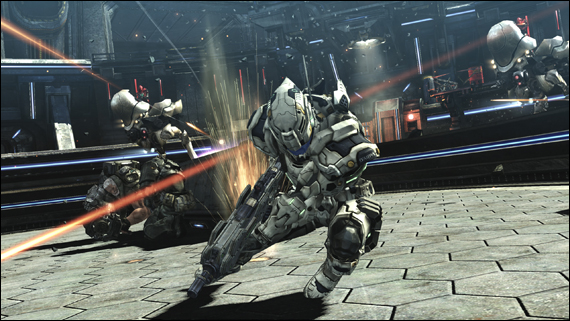
So, you understand: it’s awesome. I find the more Japanese action games I play, the more it seems the nature of every one of them is this: exactly how much is that awesome worth to me? When considering games like Lost Planet, Resident Evil, or Devil May Cry, the core gameplay mechanic is often impeccable—but in the other areas, well, that’s where you pay the price. Miserable stories and miserable storytelling seem to be mandatory, not to mention terrible voice acting. Vanquish is no exception to this rule. It’s never particularly clear where you’re going or what you’re doing, or why your objectives are important—if you even have any. In fact, your only objective seems to be to move forward, with the objective screen only listing what obstacles you need to overcome in order to proceed. In a lesser game, this could be crippling, but in Vanquish the inevitable result is that you simply don’t care; you’re too busy laughing your ass off as your ram into enemies on your rocket-knees.
Also filed under “perhaps too Japanese for its own good” are the consequences for failure. Although the difficulty of Vanquish is not particularly punishing, it has the recognizable flair of consequence that characterizes many Japanese action games. In this instance, dying and restarting at a checkpoint will cause your equipped weapons to lose some upgrade progress (though dying repeatedly at the same checkpoint, mercifully, will not cause this penalty to stack). I could hardly criticize a game for creating an element of challenge, but in the case of Vanquish, the gameplay mechanic is so well crafted and beautifully realized that it can be incredibly tempting to throw caution to the wind, charge out into the battlefield and cut loose—and the realization that you’d best not try that cool stunt, for fear of failure, can dampen one’s fun. However, patient players can circumvent this penalty by choosing to quit to the title screen upon death, and then reloading their last checkpoint from there.
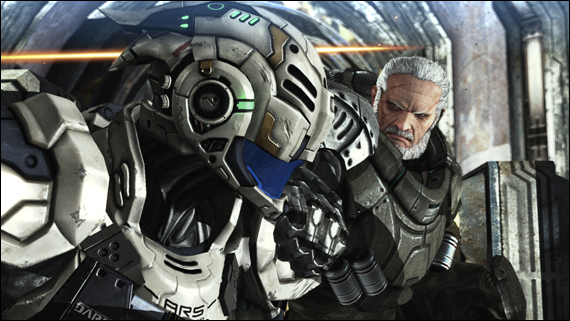
Graphically, the game is a standout effort with incredibly sharp design on the main character and his arsenal of weapons. The suit is a moving piece of machinery with pieces shifting and sliding into place as you maneuver, and this makes Vanquish a thrill to look at—even if Sam Gideon looks unsettlingly similar to a stoner I knew in college. Sam’s character model includes a visual cue demonstrating which grenade type you have equipped, and when entering slow-mo, a more prominent gauge appears (in addition to the gauge that is always displayed at the bottom of the screen). Since success will often depend on avoiding overheating, this additional gauge is invaluable.
There are some caveats, however: environmental design is sometimes strangely harsh, and the HUD is in need of some streamlining. The player score is always displayed on the screen, as is the unnecessarily large radar and equally large display of all current equipment. Accordingly, the right side of the screen is unusually heavy with HUD elements, a problem aggravated by the portraits that will pop-up on the left side of the screen when characters are communicating with Sam. While this does not strictly impede the gameplay, the clutter does dampen the visual experience, especially in a game with so much happening on the screen at any given time.
That level of activity, ultimately, is what makes Vanquish special. The game defies the cover shooter imperative, which has always been to slow the player down, ask him to take a seat, and lay on waves of enemy fire to keep him there. Vanquish seems a direct response to this style of gameplay, creating an ever-moving world and a game mechanic of impossible speed, where the player is more effective outside of cover than he is behind it, where he drifts through enemy fire as it passes slowly, harmlessly through the air. Vanquish represents something daringly new, a rare case in videogames. Gamers would be doing themselves a disservice to pass it up.
Platinum Games
Publisher
Sega
System
Playstation 3, Xbox 360 (Xbox 360 reviewed)
Modes
Singleplayer
Release Date
October 19, 2010
*A copy of this title was provided by the publisher for review
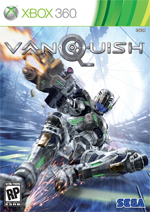
Need to download the demo to see if the game is for me. Great review Brad.
Comment by EdEN — November 4, 2010 @ 10:56 pm